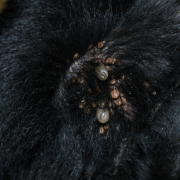Ticks may be tiny in size but they can pack a powerful punch. Not only do tick bites cause a lot of itching and irritation, but these pesky parasites also carry and transmit a number of diseases that can make your furbaby very sick.
But since they are tiny, ticks can be difficult to spot and get rid of. But fear not, pet parents! This comprehensive guide will equip you with all the knowledge you need to keep your pup safe from ticks. We’ll cover everything from the dangers of tick on dog, and prevention strategies to safe removal methods. So settle down and let’s learn how to keep those pesky ticks at bay!
What Are Ticks?
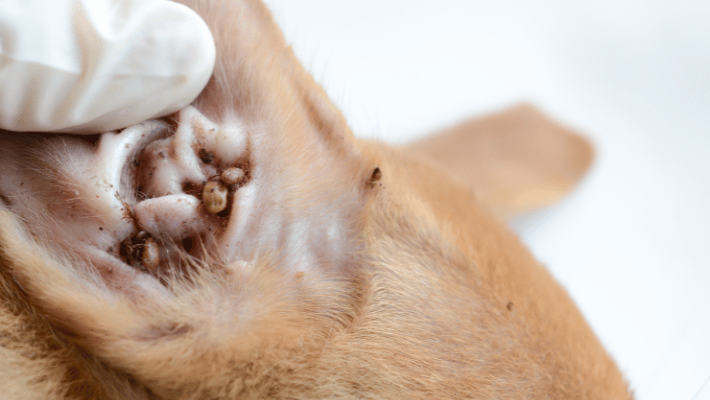
Before talking about the dangers of ticks on dogs and how to combat them, let’s take a quick look at what ticks are. Ticks are arachnids, which means they are closely related to spiders and scorpions.
Like spiders, ticks also have eight legs and oval or teardrop-shaped, flat bodies. Size-wise, adult ticks are similar to an apple seed or a sesame seed. They are typically 3 to 5 mm in length.
However, after feeding on blood, their bodies become plump and round. Ticks are parasites, which means that they prefer feeding on warm-blooded hosts. Consequently, their preferred targets are mammals and birds.
Understanding the life cycle of ticks
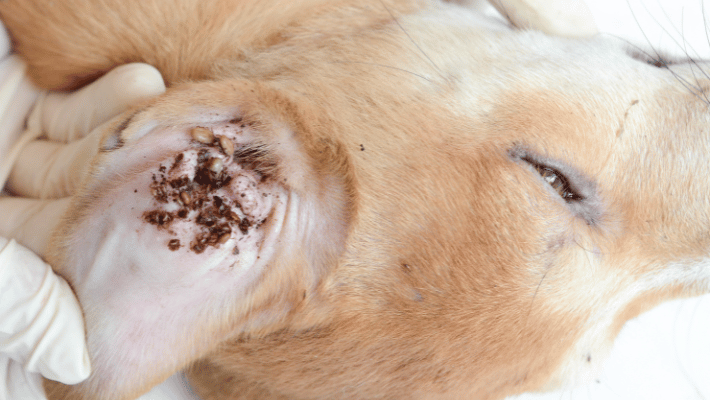
To effectively combat ticks, it’s crucial to understand their life cycle. Ticks go through four distinct stages: egg, larva, nymph, and adult. Each stage requires a blood meal from a host, such as your dog, to progress to the next stage.
The tick life cycle typically begins with an adult female laying thousands of eggs in a suitable environment. After hatching, the larvae (commonly known as seed ticks) seek out a host, such as a small mammal or bird, for their first blood meal.
Once engorged, the larvae molt into nymphs, which require another blood meal to develop into adults. Adult ticks, both male and female, then find a larger host, like your dog, to mate and feed.
Understanding this life cycle can help you identify potential tick hotspots and implement targeted prevention strategies. For example, reducing leaf litter and maintaining a well-groomed yard can help eliminate possible breeding grounds for ticks. Additionally, you also need to be aware of the common areas where ticks are found.
Common areas where ticks are found
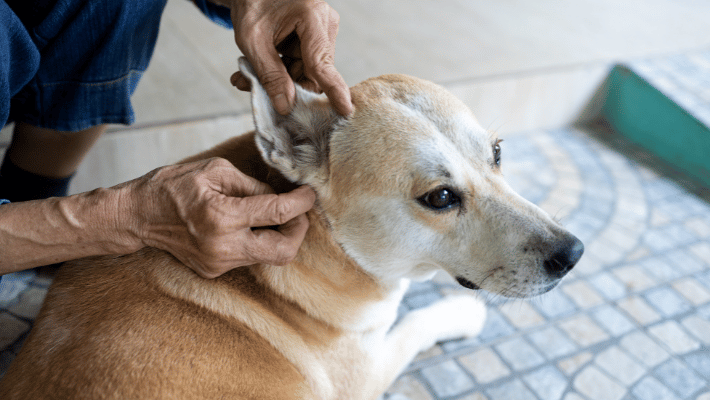
Ticks thrive in various environments, and understanding where they are commonly found can help you take preventive measures and be more vigilant during outdoor activities with your dog. These parasites are often encountered in areas with tall grass, dense vegetation, and wooded or brushy areas.
Some common locations where ticks are prevalent include:
- Hiking trails
- Grassy fields
- Wooded areas
- Leaf litter or brush piles
- Areas with high deer or rodent populations
Even your own backyard can harbor ticks, especially if it borders wooded areas or has tall grass or leaf litter. It’s essential to be aware of these potential tick habitats and avoid them as best as possible. If there are any such areas near the place where you and your furbaby generally go for a walk on a daily basis, then you need to take appropriate precautions.
What Are The Dangers Of Tick on Dogs
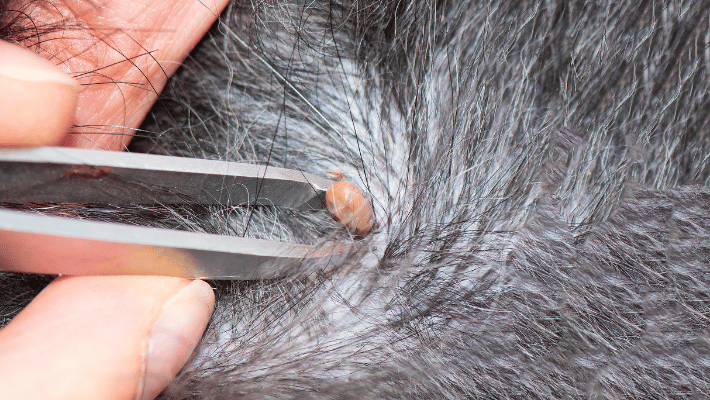
Due to their small size, ticks may seem harmless, but the truth is that they can be pretty dangerous for us and our dogs. For instance, these blood-sucking parasites carry a lot of diseases and can pass them on to our dogs. If left untreated, some of these diseases can be fatal to our dogs. We have discussed the dangers of ticks on dogs in detail below:
Skin Irritation
The most immediate danger of a tick bite is the irritation it causes at the bite site. After a tick latches on to your dog’s skin, it uses its sharp mouthparts to cut into your dog’s skin. It sounds bad, but the process is usually painless for dogs. This is because the tick injects a small amount of anesthetic along with its saliva.
The tick then inserts a feeding tube with tiny barbs into the wound to feed on blood. It also secretes salive that contains enzymes that prevent blood clotting and help the tick feed more easily. Unfortunately, these substances can also irritate the surrounding skin tissues, triggering an allergic reaction in some dogs.
Canine Ehrlichiosis
As the name suggests, Canine Ehrlichiosis is a tick-borne infectious disease that affects dogs. It’s caused by bacteria of the genus Ehrlichia, with Ehrlichia canis being the most common species responsible for the infection. The disease is primarily transmitted through the bite of infected ticks, particularly the brown dog tick.
The symptoms of canine ehrlichiosis can vary and are typically categorized into three stages: acute, sub-clinical, and chronic.
Acute phase: This early stage of the disease may present with fever, swollen lymph nodes, respiratory distress, weight loss, bleeding disorders, and occasionally neurological disturbances.
Sub-clinical phase: During this stage, the dog may not show any outward signs of disease, which makes it particularly dangerous as the infection can go undetected.
Chronic phase: If the disease progresses, long-standing infection can lead to more severe symptoms, including anemia, bleeding, and neurological problems.
If a dog is treated for canine ehrlichiosis during the acute phase, then there is a high chance that the infection will clear up and the dog will recover completely. Usually, antibiotics like doxycycline are used to treat canine ehrlichiosis in dogs.
Babesiosis
Babesiosis is an infection of the red blood cells caused by a parasite known as Babesia. It is usually transmitted through a tick bite. Once Babesia organisms enter a dog’s bloodstream, they invade and attack the red blood cells, leading to anemia.
These parasites also break down the red blood cells, releasing hemoglobin into the body and causing jaundice. Some common signs include lethargy, pale gums, fever, lack of appetite, weight loss, dark-colored urine, and discolored stool.
Babesia organisms are usually transmitted to dogs through tick bites. American dog tick, brown dog tick, and the ornate tick are the main carriers of this disease. But in some rare cases, transmission can also occur when:
- An infected dog bites a healthy dog
- A pregnant dog passes it to her unborn babies in the uterus
- A healthy dog receives a contaminated blood transfusion from an infected dog
- A dog is kept in a kennel or creche where there is poor or no tick control.
Veterinarians diagnose babesiosis with the help of blood tests to detect the presence of Babesia parasites. In addition, they also prescribe other tests like urinalysis, blood biochemical profile, and electrolyte panel to confirm the diagnosis.
Lyme disease

Also known as Borreliosis, it is a type of bacterial infection caused by the bacteria Borrelia burgdorferi. It is transmitted to dogs through the bite of infected ticks, particularly the western black-legged tick and deer tick.
These ticks get infected with Borrelia burgdorferi bacteria while feeding on the blood of rodents and birds. These bacteria start multiplying within the tick’s body and enter a dog’s bloodstream when an infected tick feeds for at least 36-48 hours (about 2 days).
Some common indicators of Lyme disease in dogs are high fever, lameness, weakness, increased thirst, diarrhea and vomiting.
Prevention methods for ticks on dogs
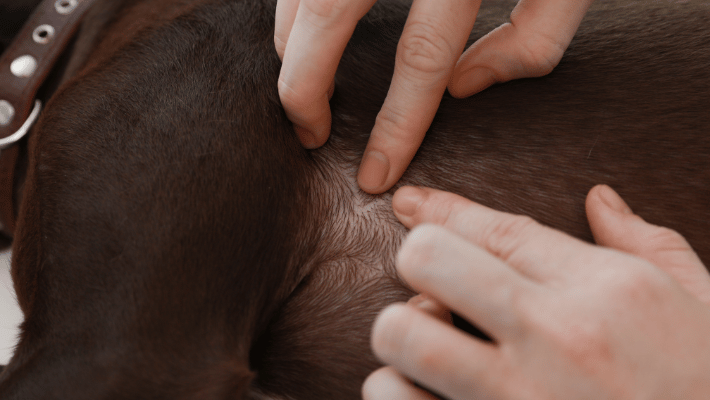
Preventing tick infestations is the most effective way to protect your dog from the risks associated with these parasites. By implementing and following a tick prevention strategy at home, you can significantly reduce the chances of your furry friend becoming a host to ticks and the diseases they may carry. Here are some proven prevention methods to consider:
Tick preventative medications
Consult your veterinarian about the best tick-prevention medication for your furbaby. Some of the available options are tick collars, topical solutions, prescription oral medications, and over-the-counter tick prevention medication, such as spot-on treatments. These products can effectively repel or kill ticks before they attach to your dog.
Grooming and inspections
Regular grooming and thorough inspections after outdoor activities can help detect and remove ticks before they have a chance to attach and transmit diseases. For instance, if you live in a tick-infested area, then get into the habit of doing a thorough body check of your dog after walks or outdoor playtimes. Focus on areas where ticks like to attach themselves, such as the ears, paws, armpits, groin, and around the tail.
Avoid high-risk areas
When possible, avoid areas known to have high tick populations, such as dense woods or tall grass. If you must go into these areas, take extra precautions and conduct thorough tick checks after your outing.
Also, keep your yard well-groomed by mowing the lawn regularly, removing leaf litter, and trimming bushes and tall grasses. This can help eliminate potential tick habitats near your home.
By implementing a combination of these prevention methods, you can significantly reduce the risk of tick infestations and the potential health consequences for the canine member of your family.
Tips on how to remove ticks on dogs
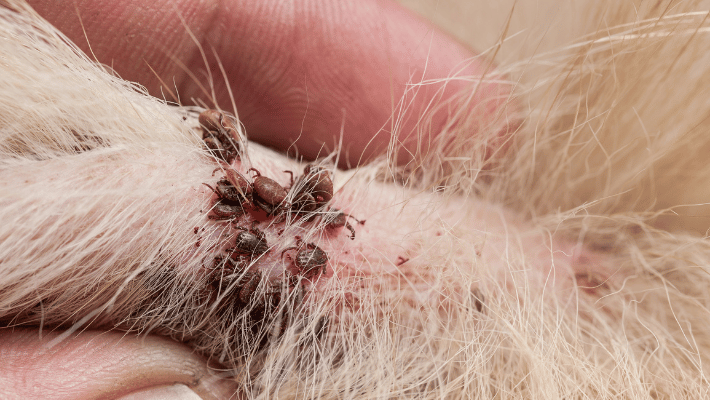
Despite your best prevention efforts, it’s possible for ticks to find their way onto your dog. In such cases, prompt and proper removal is crucial to minimize the risk of disease transmission and prevent further infestation. Here is a step-by-step guide on safe and effective tick removal:
Step 1: Use fine-tipped tweezers
Spread your dog’s fur and grab the tick as close to your dog’s skin as possible using fine-tipped tweezers or a tick removal tool (available at pet stores). When grasping a tick on your dog’s skin, avoid squeezing the tick’s body, as this can cause it to release infectious fluids.
Step 2: Pull straight up
Very gently pull the tick straight up and out, using a slow, steady motion. Avoid twisting or jerking, as this can cause the mouthparts of the ticks to break off, which will then remain embedded in your dog’s skin. Remember to never use your finger to remove a tick from your dog’s skin. It is an ineffective method, as your fingers may cause the mouth parts of the tick to break off, which can then get stuck in your dog’s skin.
You may unknowingly squeeze the tick while removing it, which can result in infectious material being injected into your dog’s body. You should also wear disposable gloves even if you are using a tweezer or a tick removal tool.
Step 3: Dispose of the tick properly
After removal, dispose of the tick by wrapping it in a tissue and flushing it down the toilet. You can also place it in a sealed container filled with rubbing alcohol or disinfectant. It is very important to dispose of ticks properly so that they do not reappear.
Step 4: Clean the bite site
Once you have gotten rid of the tick, make sure to wash your hands thoroughly with soap and water. Then, clean the tick bite site with dog-friendly soap or disinfectant and warm water. After cleaning the area, follow up with an antiseptic solution to prevent any infection. You also need to clean and disinfect the tweezers or the tick removal tool using rubbing alcohol.
Monitor for signs of illness
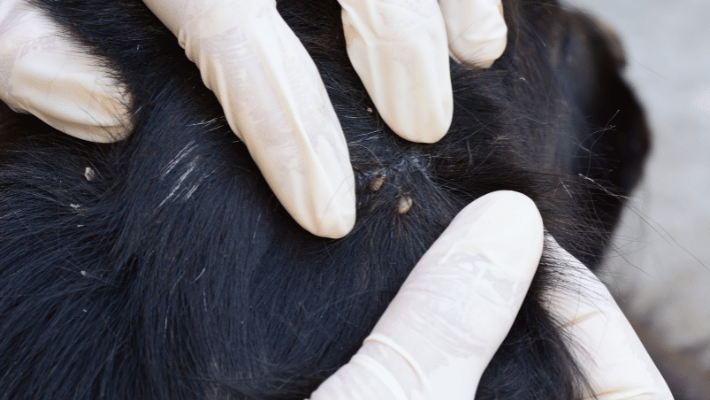
Keep a close eye on your dog in the weeks following a tick bite for any signs of tick-borne illness. Some of the common symptoms are skin rash, inflammation, lethargy, fever, and loss of appetite. If you notice any of these symptoms, you should call your vet immediately.
Remember, prompt and proper tick removal is crucial to minimize the risk of disease transmission and prevent further infestation. If you have any concerns or face any difficulties while removing a tick, consult your veterinarian for guidance.
Wrapping Up
Keeping your dog free of ticks, fleas, and other pesky parasites is an essential aspect of pet parenthood. It may seem overwhelming at first, but if you follow the prevention methods outlined above, you will be able to easily prevent tick infestation and minimize the risk of tick-borne diseases.
However, if your dog has already been infested with ticks or is showing signs of a tick-borne illness, then don’t hesitate to call your veterinarian. Early detection and treatment can make a significant difference in your fur baby’s health and well-being.
So, stay informed, take proactive measures, and do not let ticks ruin the precious and already short time you get to spend with your fur baby.
READ ALSO:
- Preventing And Treating Common Dog Allergies
- All You Need to Know About Crusty Scab on Dog and How to Deal with It
- Decoding Skin Cancer Lump On Dog: Signs, Diagnosis, And Treatment Options




